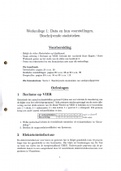Summary
Summary marketing research methods - all exam material
- Course
- Institution
- Book
An extensive summary of all the exam material for the course 'marketing research methods', given at the RUG as part of the MSC marketing management. The summary is extensive and therefore, you don't need to buy or read the materials yourself. Good luck with studying for the exam!
[Show more]













